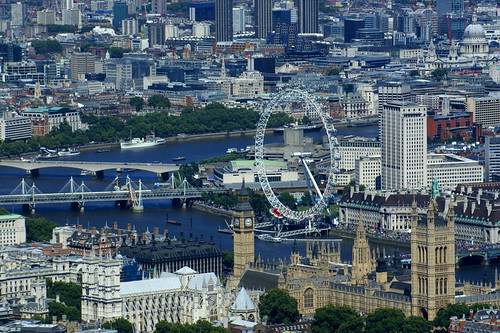Citycape,
Helicopter ride over London - Big Ben, Houses of Parliment, Westminster Bridge, Waterloo Bridge, London Eye & The Thames, London
Helicopter ride over London
A helicopter sight seeing tour is one of the best ways to see the sights of London. To truly appreciate London, jump in a helicopter and see our Capital city from the air. The helicopters used for these sight seeing tours are renowned as being amongst the world's most comfortable and reliable aircraft and, as you might expect, the views through the cabin windows are excellent. Your flight experience will last approximately thirty minutes, depending on air traffic, and provides you with a full view of London as soon as you take off. Lifting off from the helipad your experienced pilot will follow the River Thames flying at approx 1500ft, providing you with excellent views of London, including: The Thames Barrier, London City Airport, the O2 Millenium Dome, Greenwich, Isle of Dogs, Canary Wharf, Buckingham Palace, Tower Bridge, London Bridge, The City, St Paul's, Trafalgar Square, The London Eye, Houses of Parliament and MI6 building.
Big Ben, Houses of Parliment, Westminster Bridge, Waterloo Bridge, London Eye & The Thames, London, originally uploaded by Craig Grobler.
Houses of ParlimentWhere Parliament now stands has been a centre of authority for over a thousand years. Once the home of the royal family, and still officially a royal palace, the buildings that now make up the modern Houses of Parliament have developed through design, accident and attack.
Westminster Hall is the oldest part of Parliament. The walls were built in 1097 and the hall is one Europe’s largest medieval halls with an unsupported roof. It was extensively rebuilt during the 14th century.
Once used as a law court, the hall has held several notable trials, including that of Sir William Wallace (1305), the Gunpowder Plot conspirators (1606) and King Charles I (1649).
Today the hall is often used for important State occasions such as the Queen’s Golden Jubilee and the lying-in-State of the late Queen Elizabeth the Queen Mother, both in 2002.
Westminster Bridge
Westminster Bridge is a road and foot traffic bridge over the River Thames between Westminster, Middlesex bank, and Lambeth, Surrey bank in what is now Greater London, England.
For over 500 years, the nearest bridge to London Bridge was at Kingston. Proposals for a bridge at Westminster had been made as early as 1664. These were opposed by the Corporation of London and the watermen. Despite further opposition in 1722 and after a new timber bridge was built at Putney in 1729, the scheme received parliamentary approval in 1736. Financed by private capital, lotteries and grants, Westminster Bridge, designed by the Swiss architect Charles Labelye, was built between 1739-1750. It was only the second bridge crossing to be built across the Thames below Kingston when opened.
Waterloo Bridge
Waterloo Bridge is a road and foot traffic bridge crossing the River Thames in London, England between Blackfriars Bridge and Hungerford Bridge. The name of the bridge is in memory of the British victory at the Battle of Waterloo in 1815. Thanks to its location at a strategic bend in the river, the views of London (Westminster, the South Bank and London Eye to the west, the City of London and Canary Wharf to the east) from the bridge are widely held to be the finest from any spot at ground level.
The first bridge on the site was designed in 1809-10 by John Rennie for the Strand Bridge Company and opened in 1817 as a toll bridge. The granite bridge had nine arches, each of 120 feet (36.6 m) span, separated by double Grecian-Doric stone columns and was 2,456 feet (748.6 m) long, including approaches. Before its opening it was known as 'Strand Bridge'. It was nationalised in 1878 and given to the Metropolitan Board of Works, who removed the toll from it. Serious problems were found in its construction and the new owners reinforced it. Paintings of the bridge were created by the French Impressionist Claude Monet and English Impressionist, John Constable.



















0 comments: